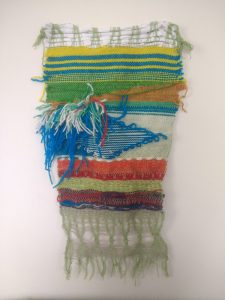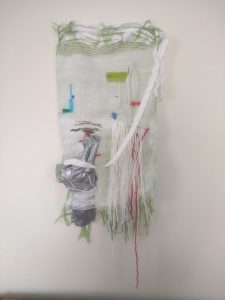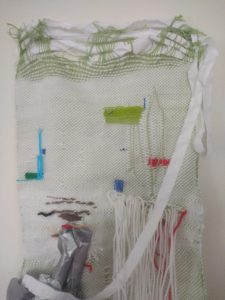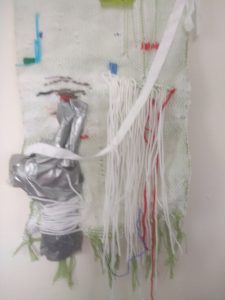Final Weaving – Anne He
Final

Sample
Intention
My starting inspiration for this piece was stress culture at CMU. I wanted to shed light on the effects of stress and mental illness, which are often normalized and inadequately addressed here. When I began this piece, I was loosely inspired by artist Angela He (@zephybite) because I wanted to contrast conventional art with darker themes. However, I quickly realized that creating a painterly style in a woven medium was no small feat, and I could not complete it to the degree I was satisfied with, so I went with a more minimalistic abstract approach. I wanted to construct a sense of chaos and deterioration in a controlled, deliberate way, as a sort of artistic irony. In my sample weaving, there were subtle details that a viewer would not notice unless they were looking at the piece closely, and I wanted to incorporate that into this piece. I was also inspired by Morse code, so I encoded messages by skipping over warp threads in a way that would seem haphazard at a glance. People often hide or disguise their struggles, so I wanted to represent that through these hidden details.
Process
I wove with a completely white base to represent conformity and blankness. I used a very limited palette for the weaving itself. I used black and brown yarns to create an abstract eye shape, and peach and red yarns to suggest flesh. The warp was a muted green, which lent a sickly tone to the piece. At the beginning of the weaving, I made sure to maintain straight, even lines and neat selvages. As the piece progressed, I wanted there to be more errors and more uneven edges. I did so by skipping over threads and varying the tension at which I pulled the weft taut. I also consistently skipped under certain threads to leave the warp hanging out. I left an open space of warp in the middle of the weaving, and filled the hole with long rya knots, which suggested that they were spilling out of the piece. I added two red rya knots as accents that would ground the hollowed space. Underneath the area covered by the length of the rya knots, I spelled out Morse messages by skipping 1 warp yarn for dots and skipping 2 warp yarns for dashes. I wanted to incorporate a foreign 3D element to the piece, as some kind of outside interference. Initially, I wanted to weave a mannequin hand into the piece, but I was unable to acquire one within the time frame of the project. Instead, I chose to make a duct tape hand because it was also an artificial material and contributed to the chaotic aesthetic of the piece. I made the hand by wrapping my hand in plastic wrap, and covering it in duct tape. I cut the duct tape off of my hand and taped it back together. I wove the hand into the piece by maneuvering the weft over the hand and back into the main weaving. I finished the piece with a jagged, slightly sloped edge. I cut the threads on the top of the weaving so that the starting fabric would naturally unravel, and I draped the end of the fabric across the piece as if the hand was unraveling the weaving. After taking the weaving off of the loom, I added embroidery in various colors for a patchwork effect.
Learning
I learned that weaving takes a lot of patience and dedication. Just creating the shape for the area of the “eyes” took over 3 hours, and for much of the piece, I was unable to properly pack the weft with the heddle and had to use hands or a fork. During the critique, there were a variety of interpretations of my project, and I found it interesting that the piece could mean something different to every individual viewer, since I could also see where they were coming from. Fittingly, I did not have as much time to spend on this project as I would have liked, so for next time I would like to make a longer weaving or make a collection of weavings. If I had more time, I would also retry my initial idea of incorporating a more detailed, painterly style that gradually becomes more abstract.


